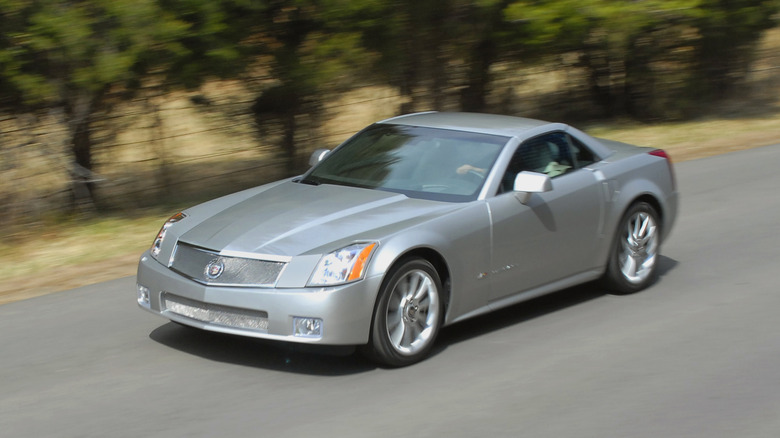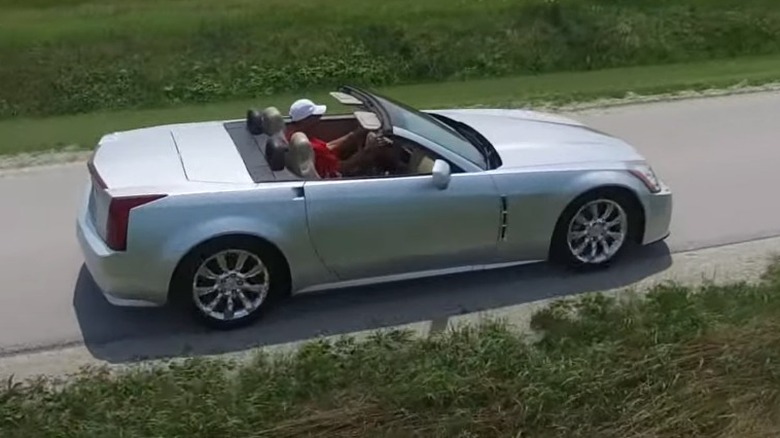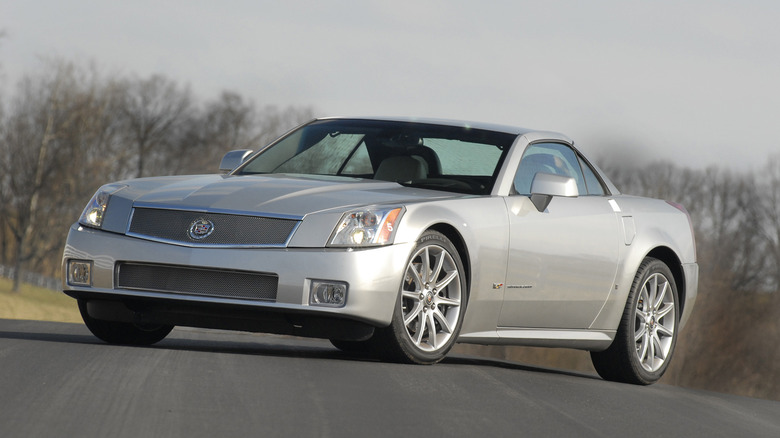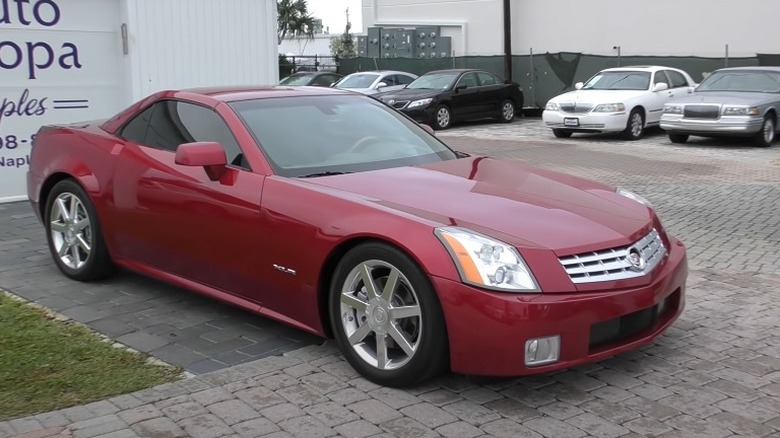The Reason The Cadillac XLR Was A Failure
Cadillac adopted the "The Standard of the World" slogan after winning the prestigious Dewar Trophy in 1908, the Nobel Price of car engineering, according to America's Car Museum. The Dewar Trophy is a salute to Cadillac's advancements in precision machining and parts interchangeability. Cadillac won the Dewar trophy again in 1912 for pioneering the electric starter and electric auto lights, further cementing the brand's reputation for producing the world's best cars.
Cadillac recently unveiled its most powerful SUV, the 682-horsepower Escalade-V, and the brand left a lasting impression with its luscious Blackwing sedans. But if there's one thing missing from Cadillac's portfolio, it has to be the two-door roadster. This brings to mind the fabulous Cadillac XLR that first debuted in 2003.
The Cadillac XLR was the automaker's flagship sports car. It had all the necessary elements to make it great. It even spawned a higher-performance model called the XLR-V and is among the first to wear Cadillac's V badge alongside the CTS-V. Despite this, the XLR made its farewell in March 2009 after a short six-year production run.
Cadillac XLR: Posh Corvette
The Cadillac XLR made its prototype debut as the Evoq Concept at the 1999 Detroit Auto Show. According to Auto Trends, equipped with a rear-wheel drivetrain (RWD) and a retractable hardtop roof, the Evoq made good use of Chevrolet's fifth-generation Corvette platform, and the concept garnered praise for its sleek design and hair-raising performance credentials. It wasn't until 2003 that General Motors debuted the production-intent XLR riding on the sixth-gen Corvette platform and built alongside GM's flagship sports car in Bowling Green, Kentucky.
The XLR had the hydroformed frail-rail bones of the C6 Corvette and a V8 engine, although not the V8 you might've expected. While this vehicle was based on the Corvette, the XLR made do with GM's 4.6-liter Northstar V8 with 320 horsepower and 310 pound-feet of torque. And to help balance the weight distribution, the XLR had a rear-mounted five-speed automatic transaxle. The five-speed eventually gave way to a smoother and slicker six-speed automatic gearbox in 2007.
Since we're talking about a Caddy, the XLR was brimming with luxury appurtenances. The standard features list included magnetic suspension, a heated tiller with tilt and telescoping functions, keyless entry, eight-way power seats, 18-inch alloy wheels, dual automatic climate control, and sumptuous leather upholstery. It also had a navigation system, a DVD player, and alloy/wood trim.
A real hot-rod convertible
Cadillac unleashed the XLR-V in 2005, a car designed to compete with the BMW Ms, Mercedes-Benz AMGs, and Jaguar XKRs in the wild. The XLR-V inherited STS-V's supercharged 4.4-liter V8 engine with a proprietary Roots-type Eaton blower, continuously variable valve timing, and variable free-flow exhausts. Although lower in displacement than the STS-V's 4.6-liters, Car and Driver claims slightly reducing the size of the cylinder bore improved engine durability, allowing the driver to make full use of the updated motor's 443 horsepower and 414 pound-feet of torque output.
With its newfound prowess, the XLR-V was capable of completing the quarter-mile in about 13 seconds and went from zero to 60 mph in 4.7-seconds — not bad even by post-pandemic standards. Furthermore, the blown V8 pumped out max torque from 2,200 to 6,000 rpm, with all of it going to the rear wheels via a 6L80 six-speed automatic. The XLR-V also had updated bones like solid front and rear anti-roll bars, stiffer control arm bushings, and updated magnetic suspension settings to deliver a sportier yet plush ride.
Reality Bites
The Cadillac XLR had a few kinks in its armor. It may have looked better than the C6 Corvette from some angles, but it was a bigger car with a less potent engine, so it was slower than the Corvette. The XLR was also portlier, no thanks to its aluminum folding roof, and it tipped the scales at about 3,840 pounds (1,740 kgs) — that was about 600 pounds (272 kgs) heavier than the Corvette. And with base prices of $75,000 for a standard XLR and $140,000 for the XLR-V, the XLR was a hard sell and made it unpopular among potential buyers.
The final nail (or nails) in the coffin were the Lexus SC430, Mercedes-Benz SL500, Porsche 911 Carrera 4 Cabriolet, and the Jaguar XK8, all drop-top cabriolets in the same price range as the Cadillac XLR. The exotic names may have had (and have) the edge over the Caddy in overall quality, luxury, or all-out performance, but it's hard to argue with the XLR's exclusivity. Cadillac expected to sell 5,000 to 7,000 units of the XLR per year, said Motor1, but the automaker only sold less than 3,700 XLRs annually.
In its final year of production, Cadilac only sold 787 XLRs, and the automaker did not sell the remaining 12 cars until 2011.



